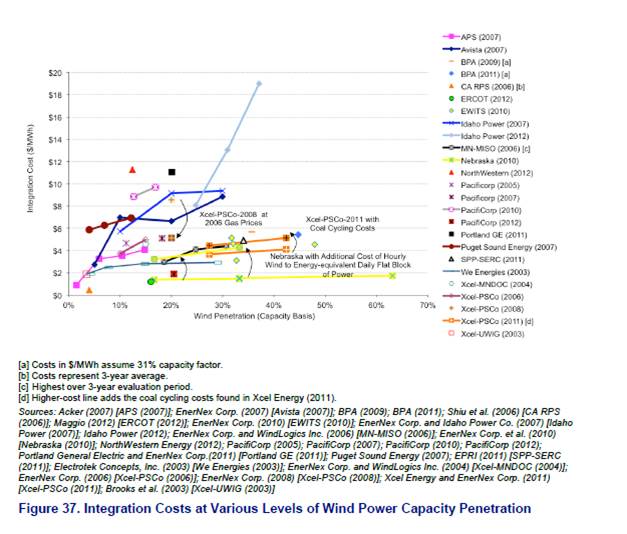Wind near-cost competitive with fossil fuels, says US Department of Energy
The latest data on US wind power provides some extraordinary statistics. During 2012 about 13 gigawatts of new capacity was installed, almost twice the UK’s total wind power. This provided about 43% of the net additions to US generating plant. Most strikingly, the Department of Energy study suggested that US wind farms are supplying power to the various regional grids at an average of $ 40 (£27) a MWh. This is broadly competitive with the cheapest gas-fired generation in the US and little more than half the current price of UK electricity. Lastly, and perhaps most interestingly from the UK perspective, the DoE study suggests that the cost to the grids of integrating wind power is less than $12 (£8) a MWh. This is a tenth of the estimated costs suggested by the Global Warming Policy Foundation last year. It’s no surprise that the DoE’s authoritative and carefully researched work isn’t currently featured on the GWPF website. Is wind competitive?
By most criteria, US wind power is now nearly competitive with fossil fuels, even in the era of cheap shale gas. The DoE report suggests that the prices agreed between wind farm owners and electricity buyers (Power Purchase Agreements or PPAs) are now roughly competitive with the top end of conventional generation.
This isn’t complete proof of cost parity – far from it. Companies installing wind turbines get substantial tax credits. But the latest data shows that the cost of onshore wind power in the US is now very roughly at the same level as gas generation. And it is lower, much lower, than the costs of any form of generation in the UK.
What about the costs of running wind alongside other sources of power?
The most aggressive and ill-informed criticisms of wind power in the UK have come from commentators suggesting that variable wind power imposes huge extra costs on the rest of the electricity system. Not so, says the US study. It looked at many different estimates of the cost of integrating intermittent wind into the US grid system. In general the figures were less than $12 a MWh, about one tenth of a recent estimate from the wild men of the Global Warming Policy Foundation.
(Some notes: this chart plots all the available estimates of wind integration in $ per MWh (y axis) with the maximum percentage of total electricity output that could be provided by wind (x axis). Sorry if this is unclear on the screen).
Add the PPA price (of say $40/MWh) to the integration cost (of say $12/MWh) and you get figure of about £35 a MWh in UK currency. Today, gas generation of electricity isn’t profitable at £50 MWh in this country. We must be doing something badly wrong if the country with the best wind resources in Europe isn’t able to get the price of wind down to below gas.
In addition to the benefits to energy consumers, the rapid expansion of wind energy in the States is aiding the US economy. Almost three quarters of all wind turbine costs were spent in the US with exports of wind equipment also growing sharply. US manufacturers continued to reduce the cost of making the turbines.
Wind is still only about 5% of US power production (about the same as in the UK) but forecasts suggest that after a weak 2013, turbine installations will pick up again. On top of 60 gigawatts of existing capacity installation companies have applied for 125 gigawatts of further transmission capacity to the grid operators. Not all of the wind farms in this queue will ever get built but wind will provide increasing fractions of US power and probably at costs roughly comparable to gas power. If it is true there, it could be true here as well.

